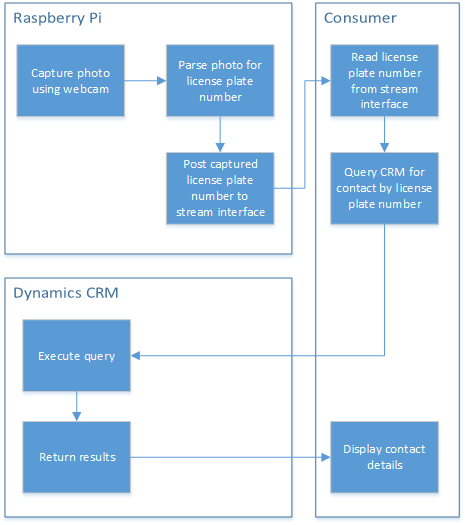Today's post is the first in a five-part series on how I integrated a Raspberry Pi with Microsoft Dynamics CRM to recognize contacts using automobile license plates. Although my solution is focused on the use of license plate numbers captured by a webcam, the solution architecture is applicable to any Dynamics CRM + Internet of Things (IoT) integration. Over the course of this series, I will show how I configured my Raspberry Pi and how I built different integrations to use the license plate data in Dynamics CRM.
Background
Last year I was working on a Dynamics CRM project for one of the largest automakers in the world, and I got to thinking about whether it'd be possible to integrate license plate recognition with our CRM system. This would have given dealers a tool so that service advisers could immediately see customer details and service preferences as soon as a car drove into a service bay. My idea never went anywhere, and eventually I moved on to a different company, but I'd still think about it every once in a while.
Then I saw an article last week about open-source license plate reader software called OpenALPR that got me thinking about this again. Because I'd just gotten a Raspberry Pi 2, and I had an old webcam that was just gathering dust in my office, I finally had everything I needed to build a Dynamics CRM license plate reader integration.
The approach
Thinking about this from the perspective of a CRM user who wants to be able to recognize a contact based on a license plate, there are a few obvious elements required:
- Camera to capture a license plate image
- Software to parse the license plate number from image (OpenALPR)
- Code to trigger the license plate number parsing and return results to a consumer
- Field to store license plate numbers in CRM
- Code to retrieve and display the CRM contact details
The right way to put these together is less obvious because there are several possible approaches, but none are appropriate in all scenarios. For example, if the CRM user is going to trigger the license plate recognition in CRM, there are at least three potential approaches:
- CRM custom assembly - Using a web resource, a dialog or some other interactive mechanism, a custom workflow activity or plug-in is called that instructs the Raspberry Pi to take a picture and return the parsed license plate number. The code hosted in CRM then searches for a contact with the returned license plate number and displays its details to the user. This approach requires that the CRM server be able to communicate with the Raspberry Pi, which may be challenging for CRM Online deployments.

- JavaScript in web resource - Using a web resource, JavaScript is called that instructs the Raspberry Pi to take a picture and return the parsed license plate number. Once a license plate number is retrieved, the JavaScript code then queries CRM for a contact with the returned license plate number and displays its details to the user. As long as the CRM end user's computer can access the Raspberry Pi, it doesn't matter if the Pi is visible to the CRM server, so this easily works with CRM Online.

- Business logic on the Raspberry Pi - Using a web resource, JavaScript is called that instructs the Raspberry Pi to take a picture and parse the license plate number. Once a license plate number is retrieved, the Raspberry Pi then queries CRM for a contact with the returned license plate number and returns its details to the user. I don't love this approach because it requires extra effort to get the Pi to communicate with CRM, and I prefer to keep the Pi as "dumb" as possible.

If the license plate recognition is triggered via camera motion detection, a physical button or a sensor without direct input from the CRM user, there are at least two potential approaches:
- Streaming interface - The Raspberry Pi takes a picture, parses the plate number and writes it to a streaming interface using Socket.IO or a similar mechanism. A web page or client application picks up the plate numbers from that interface, and then it queries CRM for a contact with the returned license plate number to display the details to the user. This approach is basically a variation on what I described in my "Creating a near real-time streaming interface for Dynamics CRM with Node.js" series last year.

- Back-end data post - The Raspberry Pi takes a picture, parses the plate number and posts it to CRM. The data can be posted directly to CRM or use a message queue. This approach is good if a CRM user doesn't need immediate access to the data.

In this series I will show how I built solutions that demonstrate three of the approaches above:
- CRM custom assembly
- JavaScript in web resource
- Streaming interface
As for why I'm not showing the other approaches:
- I just don't think the business logic on the Raspberry Pi approach is useful here. I'm sure there are times it might make sense, but my hypothetical scenario here isn't one of them.
- The back-end data post approach is almost the same as the streaming interface, except the Pi posts the data to CRM instead of Socket.IO.
In my next post, I'll show how I set up my Raspberry Pi to handle the basic license plate capture and parsing operations. See you then!